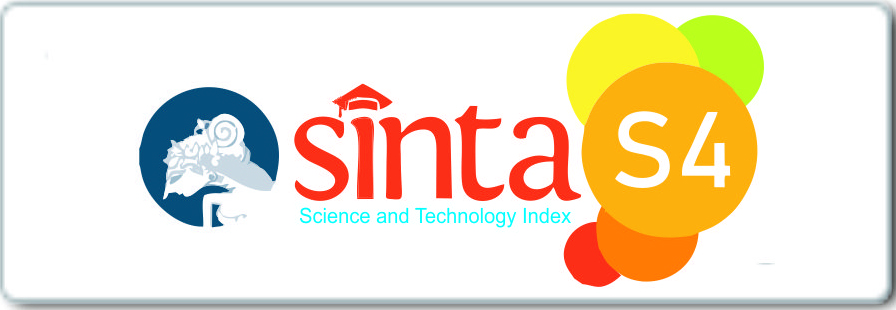The Effectiveness of Photodynamic Therapy as An Adjunct to Mechanical Debridement in Peri-Implantitis Treatment
Downloads
Background: Peri-implantitis is one of many factors that can cause implant failure, with common cases ranging from 1%-47% and the highest incidence ranging from 10.7%- 47.2%. Mechanical debridement (MD) is currently the standard for peri-implantitis treatment. However, MD has limitations in the removal of infected tissue. Moreover, the rough texture of the implant's surface and bacteria adhesion and colonization increases the difficulty in performing MD. To overcome these limitations, adjunct therapy is needed to increase peri-implantitis treatment effectiveness. One of those adjunct therapies, photodynamic therapy (PDT), is used to destroy bacterial cells and significantly reduce inflammatory cell infiltration around the implant. Purpose: To describe the effectiveness of PDT as an adjunct therapy to MD in periimplantitis treatment through narrative review. Review: PDT is effective in reducing the number of bacteria, plaque index (PI), bleeding on probing (BOP), probing depth (PD), crestal bone loss (CBL), and excessive proinflammatory cytokines (IL-6, IL-1β, TNF-α) in patients. However, the effectiveness of PDT can be influenced by several factors, including patients' conditions, such as diabetes and smoking habits, types of photosensitizers used, and exposure time. Conclusion: PDT is an effective adjunctive therapy to MD in peri-implantitis treatment since it can improve clinical parameter values, significantly reduce P. gingivalis, and decrease proinflammatory cytokines.
Singh R, Parihar AS, Vaibhav V, Kumar K, Singh R, Jerry JJ. A 10 years retrospective study of assessment of prevalence and risk factors of dental implants failures. J Fam Med Prim care. 2020 Mar;9(3):1617–9.
Ting M, Craig J, Balkin BE, Suzuki JB. Peri-implantitis: A Comprehensive Overview of Systematic Reviews. J Oral Implantol. 2018 Jun;44(3):225–47.
Ahmed P, Bukhari IA, Albaijan R, Sheikh SA, Vohra F. The effectiveness of photodynamic and antibiotic gel therapy as an adjunct to mechanical debridement in the treatment of peri-implantitis among diabetic patients. Photodiagnosis Photodyn Ther. 2020 Dec;32:102077.
Tavares LJ, Pavarina AC, Vergani CE, de Avila ED. The impact of antimicrobial photodynamic therapy on periimplant disease: What mechanisms are involved in this novel treatment? Photodiagnosis Photodyn Ther. 2017 Mar;17:236–44.
Wada M, Mameno T, Otsuki M, Kani M, Tsujioka Y, Ikebe K. Prevalence and risk indicators for peri-implant diseases: A literature review. Jpn Dent Sci Rev. 2021 Nov;57:78–84.
Abduljabbar T. Effect of mechanical debridement with and without adjunct antimicrobial photodynamic therapy in the treatment of peri-implant diseases in prediabetic patients. Photodiagnosis Photodyn Ther. 2017 Mar;17:9–12.
Alqahtani F, Alqhtani N, Alkhtani F, Divakar DD, Al-Kheraif AA, Javed F. Efficacy of mechanical debridement with and without adjunct antimicrobial photodynamic therapy in the treatment of peri-implantitis among moderate cigarettesmokers and waterpipe-users. Photodiagnosis Photodyn Ther. 2019 Dec;28:153–8.
Gabrić D, Budimir A, Bago I, Marković L, Pavlić V, Azizi B. Evaluation of the Antimicrobial Efficacy of Different Types of Photodynamic Therapy on the Main Pathogenic Bacteria of Peri-Implantitis. In: Photodynamic Therapy - From Basic Science to Clinical Research. IntechOpen; 2021.
Albaker AM, ArRejaie AS, Alrabiah M, Al-Aali KA, Mokeem S, Alasqah MN, et al. Effect of antimicrobial photodynamic therapy in open flap debridement in the treatment of periimplantitis: A randomized controlled trial. Photodiagnosis Photodyn Ther. 2018 Sep;23:71–4.
Zhao Y, Pu R, Qian Y, Shi J, Si M. Antimicrobial photodynamic therapy versus antibiotics as an adjunct in the treatment of periodontitis and peri-implantitis: A systematic review and meta-analysis. Photodiagnosis Photodyn Ther. 2021 Jun;34:102231.
Labban N, Shibani N Al, Al-Kattan R, Alfouzan AF, Binrayes A, Assery MK. Clinical, bacterial, and inflammatory outcomes of indocyanine green-mediated photodynamic therapy for treating periimplantitis among diabetic patients: A randomized controlled clinical trial. Photodiagnosis Photodyn Ther. 2021 Sep;35:102350.
Almohareb T, Alhamoudi N, Al Deeb M, Bin-Shuwaish MS, Mokeem SA, Saad Shafqat S, et al. Clinical efficacy of photodynamic therapy as an adjunct to mechanical debridement in the treatment of per-implantitis with abscess. Photodiagnosis Photodyn Ther. 2020 Jun;30:101750.
Ohba S, Sato M, Noda S, Yamamoto H, Egahira K, Asahina I. Assessment of safety and efficacy of antimicrobial photodynamic therapy for peri-implant disease. Photodiagnosis Photodyn Ther. 2020 Sep;31:101936.
Cieplik F, Deng D, Crielaard W, Buchalla W, Hellwig E, Al-Ahmad A, et al. Antimicrobial photodynamic therapy - what we know and what we don't. Crit Rev Microbiol. 2018 Sep;44(5):571–89.
Polat E, Kang K. Natural Photosensitizers in Antimicrobial Photodynamic Therapy. Biomedicines. 2021 May 21;9(6):584.
Kwiatkowski S, Knap B, Przystupski D, Saczko J, KÄ™dzierska E, Knap-Czop K, et al. Photodynamic therapy - mechanisms, photosensitizers and combinations. Biomed Pharmacother. 2018 Oct;106:1098–107.
Niculescu A-G, Grumezescu AM. Photodynamic Therapy”An Up-to-Date Review. Appl Sci. 2021 Apr 17;11(8):3626.
Copyright (c) 2022 Agung Sosiawan, Imam Safari Azhar, Devin Elysia Dhywinanda, Jesslyn Jordana, Jennifer Fiona Salim, Alexander Patera Nugraha

This work is licensed under a Creative Commons Attribution 4.0 International License.
This is an open access journal, and articles are distributed under the terms of the Creative Commons Lisence, which allows others to remix, tweak, and build upon the work non-commercially, as long as appropriate credit is given and the new creations are licensed under the identical terms.
Copyright notice:
IJDM by UNAIR is licensed under a Creative Commons Atribusi 4.0 Internasional.
- The journal allows the author to hold the copyright of the article without restrictions.
- The journal allows the author(s) to retain publishing rights without restrictions.
- The legal formal aspect of journal publication accessibility refers to Creative Commons Attribution (CC BY)
















